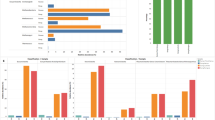Abstract.
Total number of bacteria, cellulolytic bacteria, and H2-utilizing microbial populations (methanogenic archaea, acetogenic and sulfate-reducing bacteria) were enumerated in fresh rumen samples from sheep, cattle, buffaloes, deer, llamas, and caecal samples from horses. Methanogens and sulfate reducers were found in all samples, whereas acetogens were not detected in some samples of each animal. Archaea methanogens were the largest H2-utilizing populations in all animals, and a correlation was observed between the numbers of methanogens and those of cellulolytic microorganisms. Higher counts of acetogens were found in horses and llamas (1 × 104 and 4 × 104 cells ml−1 respectively).
Similar content being viewed by others
Author information
Authors and Affiliations
Rights and permissions
About this article
Cite this article
Morvan, B., Bonnemoy, F., Fonty, G. et al. Quantitative Determination of H2-Utilizing Acetogenic and Sulfate-Reducing Bacteria and Methanogenic Archaea from Digestive Tract of Different Mammals. Curr Microbiol 32, 129–133 (1996). https://doi.org/10.1007/s002849900023
Issue Date:
DOI: https://doi.org/10.1007/s002849900023




